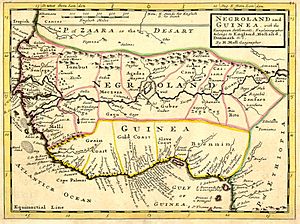Slave Coast facts for kids
The Slave Coast is a historical name for the coastal areas of modern-day Togo, Benin (which was once called Dahomey), and western Nigeria. This part of West Africa is very fertile. It was once one of the most populated areas on the African continent. From the early 1500s to the 1800s, it was a major center for the Atlantic slave trade.
Contents
What Was the Atlantic Slave Trade?
The Atlantic slave trade was a system where millions of African people were taken from their homes. They were forced onto ships and transported across the Atlantic Ocean. These people were then sold as slaves in other countries. This trade was a huge part of history. It connected Africa, Europe, and the Americas.
Where Did Enslaved People Go?
Most of the enslaved people from the Slave Coast were sent to the New World. This term refers to North and South America and the Caribbean islands. Many went to Brazil in South America. Others were taken to islands in the Caribbean. These islands included places like Jamaica and Barbados.
Busy Ports of the Slave Coast
Several important ports along the Slave Coast were used for this trade. These included:
- Ouidah
- Lagos
- Aného (also known as Little Popo)
- Grand-Popo
- Agoué
- Jakin
- Porto-Novo
- Badagry
These ports were busy places. Ships arrived from Europe and the Americas. They left carrying enslaved people.
How Many People Were Taken?
Experts believe that between 2 and 3 million enslaved people were taken from this region alone. This happened over several centuries. It was a massive movement of people.
What Was Traded for People?
Enslaved people were traded for various goods. These goods came from the Americas and Europe.
- From the Americas, items like drinks and tobacco were brought.
- From Europe, textiles (fabrics) were common trade goods.
This exchange of goods was a key part of the trade system.
A Mix of Cultures
During this time, different cultures began to mix. People from Africa, Europe, and the Americas interacted. This led to new ideas and ways of life.
- Religions started to blend.
- Architectural styles (how buildings were designed) changed.
- Languages mixed and new ones formed.
- Knowledge and skills were shared.
- New goods and foods were introduced to different places.
The End of the Trade
Eventually, European countries started to end slavery. They made laws against the slave trade. However, even after these laws, the trade did not stop immediately. Some independent traders continued to transport enslaved people. This went on for some time before the trade finally ended.


